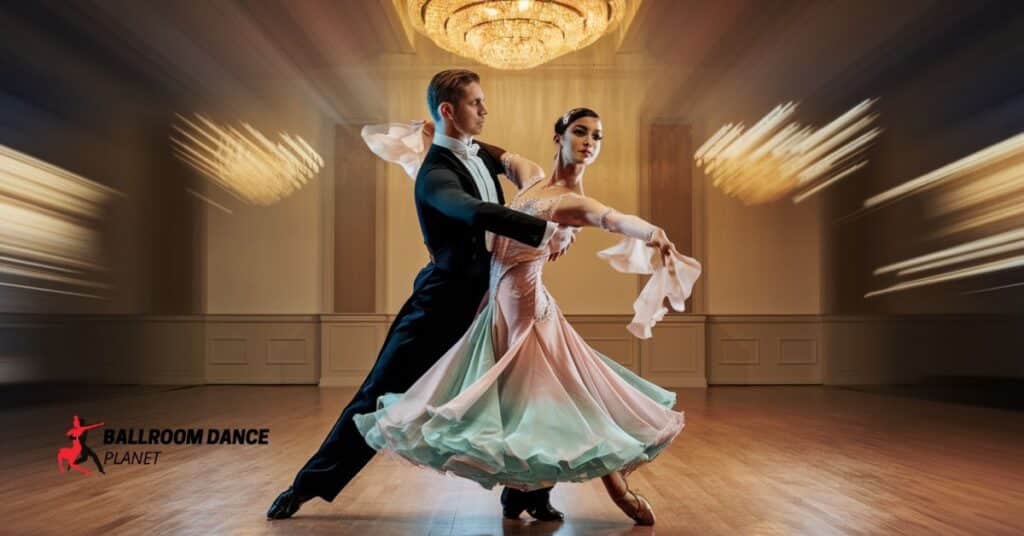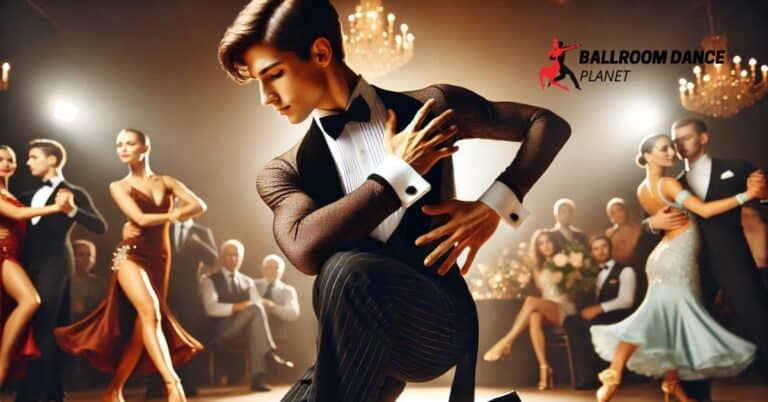Mastering The Basics: Waltz Footwork Fundamentals
Ever get lost in the music trying to figure out the rhythm of a dance? You’re not alone, especially with the waltz, which spins its magic in a 3/4 time signature. Now, don’t let that scare you off. The waltz is all about that iconic ‘1-2-3’ beat pattern that gives it its graceful, sweeping feel.
Counting the beats is where you’ve got to start. Think of it as ‘down, up, up’. The ‘1’ is your strongest beat, where you take your first step, and ‘2’ and ‘3’ are lighter, helping you glide along. It’s this pattern that helps your movement to feel smooth and continuous, like a gentle wave.

Feeling the music instead of just counting it is crucial. It’s like letting the rhythm guide you, rather than controlling it yourself. Try to listen to some classic waltz music and just tap along. Finding the beat gets easier with practice, and once you’ve got it, your feet will naturally start to follow.
Remember, the waltz is a conversation between you, your partner, and the music. Each step is a word in your dance dialogue, and getting the rhythm right makes your ‘conversation’ elegant and fluid. So, grab those dance shoes, put on your favorite waltz, and let yourself be swept up in the rhythm.
Start Strong: Waltz Posture & Frame
Getting into the rhythm of the music is fantastic, but if your posture feels like a wobbly tower, it won’t matter much. You know that time you tried walking in a straight line while balancing a book on your head? That’s the kind of upright elegance we’re aiming for here in the waltz.
Let’s talk posture. It isn’t just about standing up straight. It’s about aligning your spine, lifting your chest, and gently tucking your chin to feel as tall and balanced as possible. It feels like stretching upward but staying relaxed. Proper posture is your secret weapon—it gives you control and poise, setting you up for those smooth steps.
Your dance frame is next. Imagine a light but firm hug that doesn’t squash your partner. That’s how you should hold your partner—embrace the connection without clinching. Your shoulders are relaxed, your arms are forming a nice, supportive frame. This creates a perfect environment for leading and following, allowing both of you to move as one.
Remember, this solid frame and posture aren’t just for show. They’re crucial for executing those footwork moves with grace. A good frame helps transmit signals between partners, making your steps clearer and more coordinated. It’s like turning up the volume on your dance communication.
Staying mindful of your posture and frame transforms your waltz from shuffling around the floor to gliding with elegance. So, put your shoulders back, find that balance, and feel confident knowing your posture is carrying you beautifully through every movement.
Master the Basics: Essential Waltz Footwork Patterns
Getting your posture and rhythm in sync sets the stage, but let’s break down the moves that make everyone stop and watch. It all starts with the box step, the heart of the waltz that leads and follows both need to nail. Picture yourself drawing a square on the floor with your feet. Step forward, then to the side, then close. Repeat. Sounds simple, right? Yet it’s the foundation for everything waltzy.
The key is in the details. For leaders, start with your left foot stepping forward, while followers mirror with their right stepping back. Don’t rush or forget to glide, and keep your knees soft to flow smoothly. Common hiccup? Forgetting to fully shift your weight with each step. Practice makes perfect here.
Once the box feels like second nature, it’s time to travel across the floor with the progressive basic. Imagine you’re moving smoothly, like a ribbon across the floor. Maintain your rhythm and notes of rise and fall—the secret to making this step magical.
Then, there are the natural and reverse turns—a bit like twisting a doorknob, but for dance. They’re about turning to the right or left promptly without losing your cool. Focus on foot placement, direction, and when to pivot. Think of it like a gentle swirl, not a spin, and it’ll come naturally.
Mastering these footwork patterns unlocks endless possibilities on the dance floor. Each step and turn builds on the last, layering your skills to create elegant and flowing movements that tell your unique dance story. Stay patient and practice often, and soon enough, the waltz will feel like a beautiful second language.
Elevate Your Dance: The Rise & Fall of Waltz
You’ve got the basics down, but adding that signature rise and fall is what makes the waltz shimmer. Think of it like breathing—natural and graceful. Rise and fall add depth and emotion to your movements, making them feel more alive.
Now, here’s the trick: On the first count, use the ball of your foot to start lifting gently, letting your body naturally elevate just a bit. By the second and third counts, you’re easing back down, staying light on your toes while still grounded. This gives that floating quality everyone admires.
What’s crucial is timing. Avoid bouncing or dropping too abruptly, as it can mess with the smooth flow of your dance. It’s less about jumping and more about a controlled elevation, like a wave rising and then gently breaking.
Practicing in front of a mirror can really help you notice the flow and fluidity of your rise and fall. Visualize yourself as a piece of music, swaying gently with each note. It’s not just about looking good but feeling the movement harmonizing with the rhythm.
Keep in mind, rise and fall should never feel forced. It’s an extension of your natural movement, amplifying the gracefulness of each step you take. Master this, and you’ll notice your waltz transforms into an enchanting display of elegance.
Balance & Grace: Weight Transfer Techniques
You’ve mastered the rhythm and nailed those steps, but getting that silky smooth movement is all about how you handle weight transfer. It’s like walking on clouds—light and effortless when done right.
Every time you step, imagine you’re gently rolling your foot from heel to toe. This controlled weight shift prevents any clunky or heavy movement, allowing you to glide rather than plod. The secret lies in relaxing your ankles and knees so each transition is fluid.
Picture this: your weight shifts are not abrupt but a gradual journey from one foot to the other. Each step is cushioned by the inside edge of your foot. This technique not only improves balance but also enhances your movement’s gracefulness.
What’s great is this—understanding weight transfer means you’ll have more control, especially during those turns and transitions. Feeling grounded gives you that stability to master more complex moves with confidence.
Try practicing on a smooth surface. It’ll emphasize the importance of light pressure and precise movements. You’ll start to notice how your steps feel more connected and you move with more purpose.
Crafting that perfect balance between foot pressure and weight transfer is essential for making your waltz look effortless and dreamy. Keep practicing and embrace the process, and soon you’ll be dancing like you’re on air.
Perfect Your Steps: Troubleshooting Common Waltz Mistakes
It’s all coming together, but hey, everyone stumbles now and then. Avoiding common pitfalls can fine-tune your waltz into perfection.
Tendency to rush through the steps? It’s like being stuck in fast-forward mode. Slow it down. Focus on the beat and let patience be your partner. Dancing in harmony with the music allows for gracefully timed movements.
Heavy footwork is another hiccup. Imagine your feet have springs—light, airy. Engage the floor lightly, and float over it rather than stomping. It creates not just visual elegance but also saves energy.
Losing balance feels like walking on a tightrope. Keeping a strong posture and engaging your core is key here. Think of your core as your dance compass, guiding you and keeping everything stable.
Don’t be shy to record yourself. Watching playback can expose sneaky habits you didn’t realize you had. It’s like looking in the mirror but with pause and rewind buttons, helping you refine the smallest details.
Remember, pointing out these missteps isn’t to discourage but to enhance your routine. Embrace these fixes as stepping stones to becoming that poised waltzer everyone envies on the dance floor.
Other Basic Steps To Learn
| Step Name | Leader’s Footwork | Follower’s Footwork | Key Tips |
|---|---|---|---|
| Box Step (Basic) | Forward left, side right, close left; Back right, side left, close right | Back right, side left, close right; Forward left, side right, close left | Keep steps small and smooth; Maintain rhythm (1-2-3) |
| Progressive Basic | Forward left, side right, close left (traveling forward) | Back right, side left, close right (traveling backward) | Flow smoothly across the floor; Engage core for balance |
| Natural Turn (Right Turn) | Forward right, side left, close right (turning right) | Back left, side right, close left (turning right) | Use controlled pivoting; Maintain a strong frame |
| Reverse Turn (Left Turn) | Forward left, side right, close left (turning left) | Back right, side left, close right (turning left) | Keep weight centered to avoid imbalance |
| Rise & Fall Technique | Start low, rise on count 2, lower on count 3 | Start low, rise on count 2, lower on count 3 | Avoid bouncing; Make rise and fall gradual |
| Weight Transfer | Shift weight smoothly between steps | Shift weight smoothly between steps | Use the inside edge of feet for fluidity |
Practice Makes Perfect: Drills & Exercises for Improvement
Let’s face it, practice is where the magic happens, transforming good dancers into great ones. So here are some drills to level up your waltz footwork effortlessly.
Start with the box step, this time trying it both solo and with a partner. Practicing individually helps perfect the precision of each move, while dancing with someone else enhances your flow and connection.
Rise and fall drills make your movements as smooth as silk. Focus on transitioning between these two gracefully, repeating until it feels like second nature. Think of it as a dance between the waves and the shore.
Try slow-motion stepping to break down every element of your technique. Slowing things down sharpens your awareness of foot placement, posture, and timing, allowing you to correct any errors with ease.
Incorporate music into your practice. It’s more fun and trains your ear and body to respond instinctively to different rhythms and tempos. Plus, it gets you in the zone, making improvements feel like a breeze.
Remember, there’s no rush on this journey. Every practice session gets you closer to mastering those elegant steps you’ve been working on. Stick with it, enjoy the process, and let every step bring you closer to waltz mastery.


